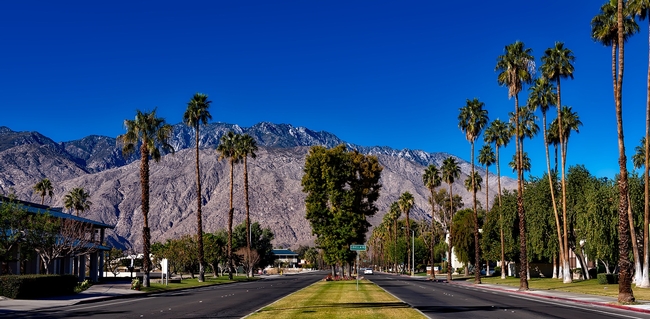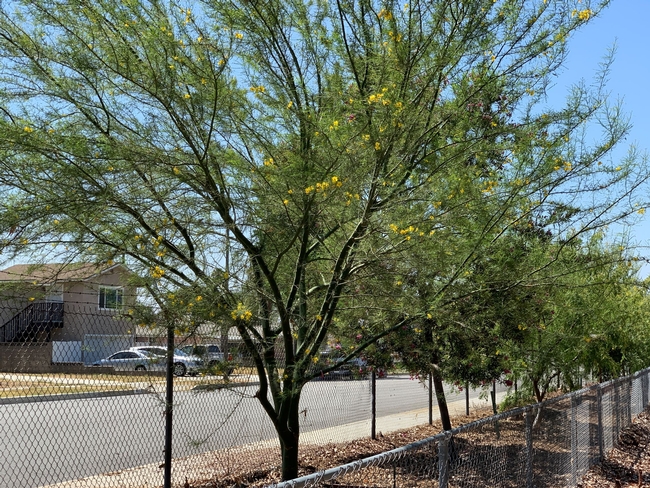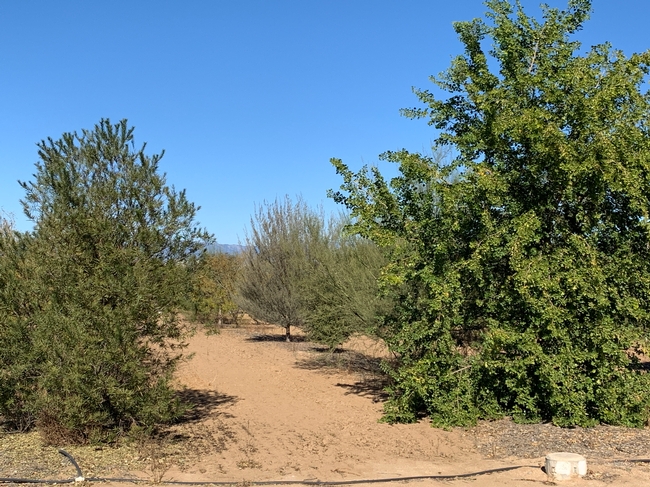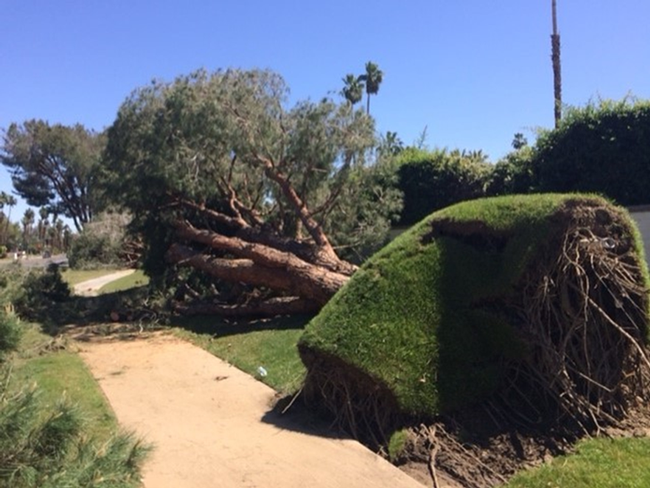Lush urban forests can help communities face climate change
Urban trees are much more than lovely greenery and stately landscape features. Scientists believe trees are a key tool for combating climate change and living with warming temperatures in California.
UC Cooperative Extension is bringing together municipal and nonprofit organizations, homeowners associations, contractors, the green industry and educators to increase the tree canopy in urban areas by planting recommended species. Nearly 200 people gathered online in March 2021 to share research results, accomplishments and tree canopy growth strategies at the “Trees for Tomorrow Start Today” workshop.
“We need to act now and together to build community forests,” said Janet Hartin, UCCE area environmental horticulture advisor in Southern California and the event organizer. “This is the time to talk about challenges and opportunities for a healthier tomorrow. As our cities grow, so do associated urban heat islands like asphalt-covered parking lots and streets.”
For decades, temperatures have been rising across the planet. While governments work worldwide to reduce carbon dioxide and other emissions that contribute to the greenhouse gases warming the earth, trees are a particularly effective way to make a significant impact on the problem at the local level.
“With proper placement around homes, trees can reduce home energy cost by 30 to 50 percent,” Hartin said. “Treeless urban parking lots can be 20 to 25 degrees hotter than park-like settings in the same area.”
Trees have myriad additional benefits. They provide cooling shade to sidewalks, schools and shopping centers. Trees remove dust from the air, create windbreaks, capture runoff, reduce glare, muffle urban noise and provide a habitat for birds and other animals. In the process of photosynthesis, trees also absorb and store carbon dioxide, helping reduce greenhouse gas emissions to the atmosphere.
With so many reasons to plant and maintain trees in urban communities, and with the overarching threat of climate change, there's no time to waste in nurturing lush green canopies in California cities, schools, parks and neighborhoods. Hartin said ensuring the proper tree selection, placement and care is critical.
“Trees improperly selected or not properly cared for are taking precious time away from the future benefit of trees,” she said.
UC conducts long-term research to identify the best urban trees
Hartin is working with a team of UC Agriculture and Natural Resources and U.S. Forest Service scientists to identify the best drought- and heat-tolerant trees for different areas of the state. Six years ago, the team vetted 100 trees native to California, the Southwest and Australia, taking into account habitat, physiology and biological interactions. A selection of fast-growing, drought-, heat- and pest-resistant species were planted at UC Riverside, the UC South Coast Research and Extension Center in Irvine and in Northern California to be evaluated over 20 years. In addition, Hartin has a subset of trees in a ‘mulch, no mulch' study at Chino Basin Water District in Montclair.
“We're beginning to see the best performers in those areas,” said Hartin, who shared a few of the tree species that have already caught her fancy.
Island Oak (Quercus tomentella) – A disease-resistant evergreen California native adapted to many Sunset magazine zones and soils.
Netleaf Hackberry (Celtis laevigata var. reticulate) – A deciduous tree with small red berries that attract birds. “This is performing beyond our expectations,” she said.
Thornless Honey Mesquite – (Prosopis glandulosa ‘Maverick') – Native to the Southwest U.S., the tree is heat tolerant and cold hardy. It grows as wide as it is tall – about 35 feet.
Pistacia ‘Red Push' (Hybrid of Pistacia atlantica × Pistacia integerrima) – Developed in Arizona, the tree grows 20-feet tall. “The foliage makes you think of Maine or Minnesota in the fall, but this tree has a brilliant red tinge when it first leafs out in the spring,” she said. “It's performing really well in our studies.”
Bubba Desert Willow (Chilopsis lineraris ‘Bubba') – “My favorite tree from our study,” Hartin said. “It grows fast, has beautiful trumpet-like flowers and requires little maintenance.”
Hartin recommends finding more details about these and other trees at http://selectree.calpoly.edu. Read more about the project here: UC study seeks street trees that can cope with climate change.
UC Master Gardeners provide advice on tree selection and maintenance
Proper location based on climate zone and specific conditions around one's home, planting and maintenance are important for tree longevity. Helpful information and support is available throughout California from UC Master Gardener Program volunteers.
Mandy Parkes of the Inland Empire Resource Conservation District said Master Gardeners are a “pivot point” for successful tree planting. She spearheaded a tree planting program in North Redlands that involves partnerships with the California Climate Action Corps, the city, ESRI, University of Redlands and UCCE to encourage residents to plant trees where the urban canopy is currently low.
“New tree owners need long-term support to aid selection and placement of trees,” Parkes said. “Master Gardeners can weigh in on yard design, irrigation and most importantly, guiding trees into the ground and caring for them correctly and in a way that works for the residents.”
Studies have shown that there is often less tree canopy cover in lower-income communities. In many under-served neighborhoods, canopy cover ranges from 0 to 11%, Hartin said, far short of the recommended 25% canopy cover.
“In wealthier neighborhoods, there tends to be higher canopy cover, and in addition, in those areas there is less asthma and cardiovascular disease,” Hartin said. “Encouraging planting in low-income neighborhoods is one of our goals.”
Andy Lyons, program coordinator for UC ANR's Informatics and GIS Statewide Program and a workshop participant said, “GIS technology and data offer exciting new possibilities for managing our urban trees, including the ability to create highly accurate maps of urban trees from aerial imagery, mobile data collection apps to monitor tree health, and the ability to overlay climate change projections for species selection and planning."
Threats to urban trees
Threats to trees were also discussed at the day-long Trees for Tomorrow meeting. West Coast Arborists' Cris Falco said he is frequently dismayed to see poorly pruned trees. “In my opinion, poor tree work is still the rule, not the exception,” he said.
A common mistake is cutting back, or heading, branches, while the goal should be a natural system of pruning to retain and promote characteristic growth. But, with 90% of the urban forest grown on private property, all too often poor tree architecture or inferior branch structure can lead to early tree failure. Falco and other speakers recommended regular pruning by a certified arborist.
Insect pests and diseases can also get in the way of long-term tree survival. Dave Rogers is a recently retired city arborist and currently acting director of the Community Services Department in Claremont, a college town in eastern Los Angeles County known as the “City of Trees and Ph.D.s.” He said the polyphagous shot hole borer reached Claremont and threated to kill heritage oaks and sycamores. Rogers gathered information and shared it with the city council, who provided $300,000 to treat infested trees. “The treatments worked,” he said.
But the pest continues to threaten trees in Los Angeles and Orange counties. One of the promising trees in the Trees for Tomorrow climate study, the Thornless Desert Museum Palo Verde, was found to be susceptible to shot hole borer, so experts are not recommending residents plant this tree.
Another pest, the ash borer, is in Eastern Texas and Boise Idaho, and will likely make its way to the West Coast eventually, said plantsman and workshop participant Nicholas Staddon of Everde Growers.
“It will kill every single ash tree we have,” said Staddon, who was a plant specialist at Monrovia Wholesale Nursery for many years. “We have to look at a broader diversity of trees. From the growers' perspective, trees are the most expensive items we grow. People who want to buy trees need to have some financial skin in the game for growing them.”
Making trees that are climate-tolerant but less common available to the public at nurseries is another hurdle. Nurseries carry what people are asking for, but people don't always know about tested species and even older, “tried and true” varieties.
“We have a list of trees adapted to the climate that are water wise, but at this point, it is difficult to find those in the nurseries,” said Debby Figoni, UC Master Gardener and water administrator for City of Beverly Hills. “It's one thing to know what you're supposed to plant. It's another to find that tree. We have to give people resources.”
The rich discussion regarding the need to enhance tree canopies with recommended species and proper long-term care did not end at the conclusion of the workshop, Hartin said.
“A goal of the workshop was to identify ways to work together more effectively across professions,” she said. “Lots of great ideas came out of the roundtable discussions that we'll be following up on. These include providing education on proper tree selection and care through local task forces consisting of members of the nursery and landscape industry and regular communication between these groups.”




